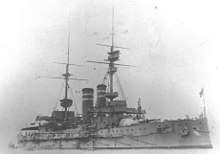5th Battle Squadron
The 5th Battle Squadron was a squadron of the British Royal Navy consisting of battleships. The 5th Battle Squadron was initially part of the Royal Navy's Second Fleet. During the First World War, the Home Fleet was renamed the Grand Fleet.
| 5th Battle Squadron | |
|---|---|
| Active | 1912–1919 |
| Country | |
| Branch | |
| Size | Squadron |
History
First World War

August 1914
In August 1914, the 5th Battle Squadron was based at Portland, and consisted of a number of pre-dreadnought battleships. These were:[1]
- HMS Prince of Wales
- HMS Bulwark
- HMS Implacable
- HMS Irresistible
- HMS Formidable
- HMS London
- HMS Queen
- HMS Venerable
Following the loss of HMS Bulwark in 1914, HMS Lord Nelson and Agamemnon were transferred from the 6th Battle Squadron. With the commissioning of the five fast battleships of the Queen Elizabeth class, the remaining pre-dreadnoughts were sent to the Mediterranean. HMS Queen Elizabeth herself was delayed in joining the squadron, instead taking part in the Dardanelles Campaign until May 1915.
Battle of Jutland
In 1916, the 5th Battle Squadron—under the command of Rear Admiral Hugh Evan-Thomas—[2] was temporarily transferred to David Beatty's Battlecruiser Fleet. On 31 May, four ships of the Squadron served with distinction in the battle of Jutland. These were:[3]
- HMS Barham Flagship of Rear Admiral H. Evan-Thomas; Captain A. W. Craig;
- HMS Valiant Captain M. Woollcombe;
- HMS Warspite Captain E. M. Philpotts;
- HMS Malaya Captain the Honourable A. D. E. H. Boyle;
In the clash with the German I Scouting Group under Admiral Franz von Hipper, the 5th Battle Squadron "fired with extraordinary rapidity and accuracy" (according to Reinhard Scheer), damaging the battlecruisers SMS Lützow and Seydlitz and a number of other German warships.
Three of the Queen Elizabeths received hits from German warships during the engagement, yet they all returned home, though Warspite—whose steering was jammed—was targeted by the German line, taking 15 hits and coming close to foundering.
After the battle, HMS Queen Elizabeth—which had missed the battle due to being in dock—rejoined the squadron.
Vice and Rear-Admirals commanding
Post holders as follows:[4][5]
| Rank | Flag | Name | Term | Notes | |
|---|---|---|---|---|---|
| Vice/Rear-Admiral, Commanding, 5th Battle Squadron | |||||
| 1 | Vice-Admiral | Sir Cecil Burney | 5 December 1913 - 14 August 1914 | and as Vice-Admiral Commanding, Channel Fleet | |
| 2 | Rear-Admiral | Cecil F. Thursby | 14 August 1914 - 20 December 1914 | ||
| 3 | Vice-Admiral | Sir Lewis Bayly | 20 December 1914 - 17 January 1915 | and as Vice-Admiral Commanding, Channel Fleet | |
| 3 | Vice-Admiral | Sir Alexander Bethell | 17 January 1915 - 25 August 1915 | and as Vice-Admiral Commanding, Channel Fleet | |
| 4 | Rear-Admiral | Sir Hugh Evan-Thomas | 25 August 1915 - 1 October 1918 | ||
| 5 | Rear-Admiral | Sir Arthur Leveson | 1 October 1918 - 7 April 1919 | ||
Second in Command
Post holders as follows:[6]
| Rank | Flag | Name | Term | Notes | |
|---|---|---|---|---|---|
| Rear-Admiral, in the 5th Battle Squadron | |||||
| 1 | Rear-Admiral | Bernard Currey | 18 November 1913 - 14 February 1915 | ||
| 2 | Rear-Admiral | Cecil F. Thursby | 29 July, - 14 August 1914 | ||
| 3 | Rear-Admiral | Lewis Clinton-Baker | 1 April 1919 - 7 April 1919 | ||
Footnotes
- Dittmar, F.J & Colledge J.J., British Warships 1914-1919 Ian Allan, London. 1972; ISBN 0-7110-0380-7
- Gordon, Andrew. The Rules of the Game John Murray. 1996; ISBN 0-7195-5076-9
- Macintyre, Donald. Jutland Evans Brothers Ltd. 1957; ISBN 0-330-20142-5
- "Senior Royal Navy appointments" (PDF). Archived from the original (PDF) on 11 July 2011. Retrieved 4 October 2014.
- Harley, Simon; Lovell, Tony. "Fifth Battle Squadron (Royal Navy) - The Dreadnought Project". www.dreadnoughtproject.org. Harley & Lovell, 1 August 2017. Retrieved 27 December 2017.
- Harley & Lovell, 2017
References
- Dittmar, F.J & Colledge J.J. (1972), British Warships 1914-1919 Ian Allan, London. ISBN 0711003807
- Gordon, Andrew. (1996), The Rules of the Game John Murray. ISBN 0719550769
- Harley, Simon; Lovell, Tony. "Fifth Battle Squadron (Royal Navy) - The Dreadnought Project". www.dreadnoughtproject.org. Harley & Lovell, 1 August 2017.
- Macintyre, Donald. (1957), Jutland Evans Brothers Ltd. ISBN 0330201425